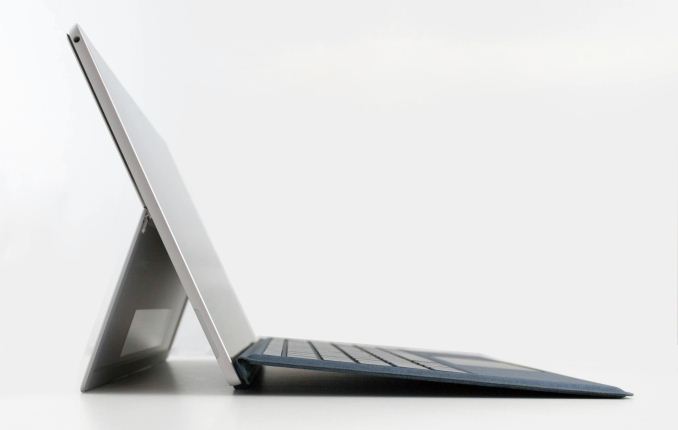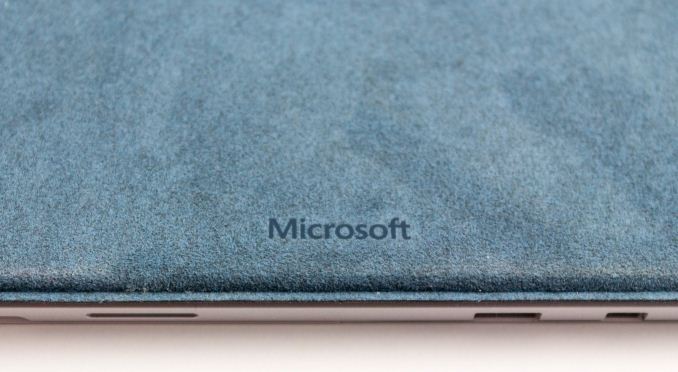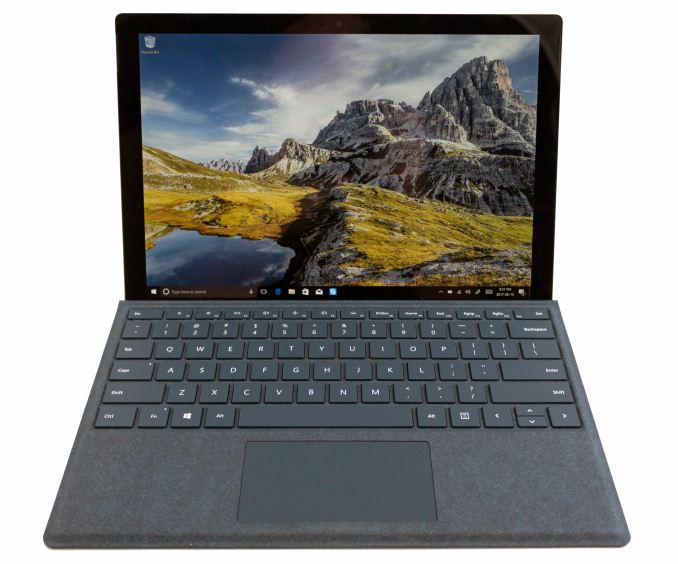The Microsoft Surface Pro (2017) Review: Evolution
by Brett Howse on June 15, 2017 9:00 AM ESTFinal Words
The Surface Pro lineup has always been one of the most powerful tablet class devices around. Microsoft is no longer marketing it as a tablet that can replace your laptop anymore though, and they’ve acknowledged that most of the customers who buy and use the Surface Pro are looking for an ultraportable laptop. That makes a lot of sense, since the Surface Pro weighs only 786 grams / 1.73 lbs for the Core i5 and i7 models, and the Signature Type Cover only adds another 310 grams / 0.68 lbs. As a complete package, it’s only 1.096 Kg / 2.41 lbs. It’s not the lightest device around, but it’s still very light and easy transport.
Packing a full 15 Watt U series Intel Core processor into such a small package has been a challenge in the past, but with improvements to both the cooling and the heat output of the CPU over the last couple of generations, it’s no longer the problem it once was. The CPU is able to run at full power in the new Surface Pro without throttling, although the new power modes will throttle it by default. This allows the Surface Pro to run almost silently for almost any task, yet still offer more processing speed than the outgoing model.
The design of the Surace Pro is mostly unchanged, if you consider the size, weight, and thickness. But the new design is softer in the hand, with rounded edges where the old models were more angular, and it is immediately noticeable when you pick it up. Surface Pro didn’t need a full redesign at all, so the small touches have done a great job without messing with what made Surface Pro so popular in the first place.
The display changes follow the same theme. It’s still the same size, and resolution, but the new display now features an “Enhanced sRGB” mode which brings a bit more vibrancy to the colors, without affecting skin tones. For color critical work, there’s still the sRGB mode, which has amazing color accuracy, but for those that are willing to sacrifice accuracy for a bit more punch, the new Surface Pro delivers that. And even in Enhanced sRGB mode, the average error level is still better than many machines on the market.
Battery life has also improved, mostly thanks to a larger capacity battery, but the new Kaby Lake chip likely helps as well. Surface Pro will always lag the best Ultrabooks in battery life, because it can’t compete on outright capacity, but Microsoft has done a great job again with platform efficiency.
The I/O port situation is not ideal, and here Microsoft seems to be taking a stand against USB-C and Thunderbolt 3, to the detriment of its customers. Offering the full-size USB port that is on there now is, without a doubt, the correct decision to make. But it seems like wasted space to offer a mini DisplayPort connecter over a USB-C port which could easily handle DisplayPort duties (and so much more). USB-C is a bit of a mess, with different ports providing different alt-mode functionality, and that will continue to be a problem, but it would have been great to see a fully capable USB-C port with Thunderbolt 3 for future connectivity. Intel has announced that they will be building more of that into their SoCs soon, so that would open the door to allowing this in future Surface Pro models without having to add extra chips on the motherboard.
Surface Pro’s accessories have always played a key role in its success, and the new Signature Type Cover with Alcantara fabric is very nice to use. Hopefully the polyurethane coating will increase durability as well. It’s available in three colors to match the Arc Mouse, and the new Surface Pen.
The Surface Pen improvements are surprisingly impressive. The existing pen on the Surface Pro 4, Book, and Studio, were all good quality digital pens, offering replaceable tips, and a fantastic traction on the display, but the new version really brings it to a new level. The sensitivity is quadrupled, from 1024 levels, to 4096, and the actuation force is decreased from 20 grams to just 9 grams, plus the new pen now supports tilt. The latency has also been reduced to just 21 ms, and from testing it out, it’s amazing how you can’t easily get the pen ahead of the ink now, where there was always a small lag before.
Microsoft didn’t need to revolutionize the Surface Pro, and rather than mess with what’s worked, they’ve continued to refine it. A softer design, a wider opening kickstand, and better accessories all bring the Surface Pro ahead of the pack again. Even after being on the market since November 2015, the Surface Pro 4 was arguably still the best product in this category, and the 2017 Surface Pro extends that lead.
Pricing makes the Surface Pro competitive, with a starting price of $799 for the Core m3 model with 4 GB of RAM and a 128 GB SSD. The base model is likely just to get people in the door though, and the Core i5 model with 8 GB of RAM and a 256 GB SSD is likely the sweet spot, although it bumps the price up to $1299. The review model, with a Core i7, 16 GB of memory, and a 512 GB SSD creeps up to $2199, and the 1TB model is $2699. These prices don’t include the keyboard cover, which starts at $129.99 for the normal version, and goes up to $159.99 for the Signature edition. Compared to the Surface Pro 4, the prices are practically identical with looking at the launch prices, although the Core m3 model is $100 less expensive. The Surface Pen used to be included though, so overall, there’s a $60 price increase for most models if you used the pen. For an Ultrabook, its entry price is right in-line with the competition.














124 Comments
View All Comments
ivan.lazarenko - Friday, June 16, 2017 - link
Brett, thank you for the great review! This evolution approach for new Microsoft Surface Pro is a pretty lame version of what the fans were expecting to be a true successor, the real Surface Pro 5You might like this video hits like the last nail in the coffin and is funny: https://www.youtube.com/watch?v=f3sC82vnR7A
UtilityMax - Saturday, June 17, 2017 - link
I have never been fan of a "laptop" that's as unstable on your laps as the Surface Pro 4, and a "tablet" that's as thick as heavy as the Surface Pro, and with such relatively poor touch GUI and the lack of much tablet apps. In other words, it was a poor laptop, and a poor tablet. The new one looks like more of the same. I'd rather by myself a Lenovo Yoga 700 or 900-series ultra-tin laptops foldable keyboard (yes, real keyboard, not keyboard "covers")serendip - Saturday, June 17, 2017 - link
Unfortunately yes, most tablets make poor laptops. Large Windows tablets also make poor tablets because they're heavy and Windows still isn't touch friendly. I'm a masochist who loves traveling light so I don't mind rocking a cheap Teclast Windows tablet. I couldn't justify spending on a Surface when it costs so much and it doesn't know what it is.damianrobertjones - Friday, August 18, 2017 - link
Why does it have to be defined as either one?mkozakewich - Saturday, June 17, 2017 - link
Okay, so there's never been anything more than rhetoric flying around about the pens. "Oh, it's so much better now!" It sounds good, but then I also hear people swear by the Apple Pencil. Is it possible to benchmark those kinds of things? Would it be possible for you to measure activation forces various pens, as well as maybe latency and pressure-levels-per-gram-of-force?Also, was the original Type Cover Alcantara? I haven't seen a word of it, but that material really surprised me when I first encountered it. It seems like it couldn't have been, because everyone is going gaga over this iteration.
Brett Howse - Saturday, June 17, 2017 - link
I haven't used the Apple Pencil for a while now, but it seems like both are pretty close in terms of usability. We can measure some of the things you mentioned, but not all, at least without new equipment which would have limited value outside of testing a stylus. But I don't have the Apple Pencil to compare it against anyway.The original Type Cover was not Alcantara, although they did release a Signature version with the synthetic fabric after the Surface Pro 4 launched.
Bullwinkle J Moose - Saturday, June 17, 2017 - link
About AnandTechA Message from Our Founder, Anand Shimpi
We are motivated by one thing and one thing only: doing right by you.
--------------------------------------------------------------------------------------
AWESOME!
Can you please investigate my claims that this Laptop is using a Gov't Sponsored Spyware Platform "OR" provide "ANY" EVIDENCE that these claims are incorrect without simply deleting my posts without explanation?
I will gladly provide hundreds of examples of spyware/extortionware and malware if you like
Can't wait for an HONEST review
THANKS!
Bullwinkle J Moose
mrbofus - Saturday, June 17, 2017 - link
"But it seems like wasted space to offer a mini DisplayPort connecter over a USB-C port which could easily handle DisplayPort duties (and so much more). But it seems like wasted space to offer a mini DisplayPort connecter over a USB-C port which could easily handle DisplayPort duties (and so much more). "It would also be nice if they got rid of the proprietary power connector and used USB-C. Two full USB-C ports and a USB-A port would have been a perfect port combination, in my opinion.
simard57 - Wednesday, June 21, 2017 - link
as someone that trips over the power cable too often, I appreciate the magnetic connector.do agree with the comment regarding replacing Mini Display Port with USB-C but that would be dependent on cost impact.
Gunbuster - Saturday, June 17, 2017 - link
Can you test Wi-Fi with Bluetooth in use? I'm wondering if they ever fixed the (extra) poor performance with it doing both...